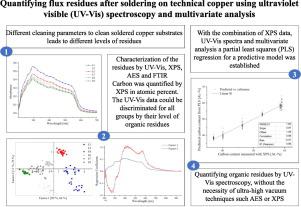Microelectronics Reliability ( IF 1.6 ) Pub Date : 2021-09-03 , DOI: 10.1016/j.microrel.2021.114367 Tim Englert 1, 2, 3 , Jan Stiedl 2, 3, 4 , Simon Green 3 , Timo Jacob 1 , Thomas Chassé 4, 5 , Karsten Rebner 2

|
Employing diffuse reflection ultraviolet visible (UV–Vis) spectroscopy we developed an approach that is capable to quantitatively determine flux residues on a technical copper surface. The technical copper surface was soldered with a no-clean flux system of organic acids. By a post-solder cleaning step with different cleaning parameters, various levels of residues were produced. The surface was quantitatively and qualitatively characterized using X-ray photoelectron spectroscopy (XPS), Auger electron spectroscopy (AES), Fourier transform infrared spectroscopy (FTIR) and diffuse reflection UV–Vis spectroscopy. With the use of a multivariate analysis (MVA) we examined the UV–Vis data to create a correlation to the carbon content on the surface. The UV–Vis data could be discriminated for all groups by their level of organic residues. Combined with XPS the data were evaluated by a partial least squares (PLS) regression to establish a model. Based on this predictive model, the carbon content was calculated with an absolute error of 2.7 at.%. Due to the high correlation of predictive model, the easy-to-use measurement and the evaluation by multivariate analysis the developed method seems suitable for an online monitoring system. With this system, flux residues can be detected in a manufacturing cleaning process of technical surfaces after soldering.
中文翻译:

使用紫外可见 (UV-Vis) 光谱和多变量分析对技术铜焊接后的助焊剂残留量进行量化
利用漫反射紫外可见 (UV-Vis) 光谱,我们开发了一种方法,能够定量确定技术铜表面上的助焊剂残留物。技术铜表面是用有机酸的免清洗助焊剂系统焊接的。通过具有不同清洁参数的焊后清洁步骤,产生了不同程度的残留物。使用 X 射线光电子能谱 (XPS)、俄歇电子能谱 (AES)、傅里叶变换红外光谱 (FTIR) 和漫反射紫外-可见光谱对表面进行定量和定性表征。通过使用多变量分析 (MVA),我们检查了 UV-Vis 数据以创建与表面碳含量的相关性。可以根据有机残留物的水平区分所有组的 UV-Vis 数据。结合XPS,通过偏最小二乘(PLS)回归对数据进行评估以建立模型。基于该预测模型,计算出碳含量的绝对误差为 2.7 at.%。由于预测模型的高度相关性、易于使用的测量和多变量分析的评估,所开发的方法似乎适用于在线监测系统。使用该系统,可以在焊接后技术表面的制造清洁过程中检测助焊剂残留物。易于使用的测量和多元分析评估 开发的方法似乎适用于在线监测系统。使用该系统,可以在焊接后技术表面的制造清洁过程中检测助焊剂残留物。易于使用的测量和多变量分析的评估所开发的方法似乎适用于在线监测系统。使用该系统,可以在焊接后技术表面的制造清洁过程中检测助焊剂残留物。



























 京公网安备 11010802027423号
京公网安备 11010802027423号